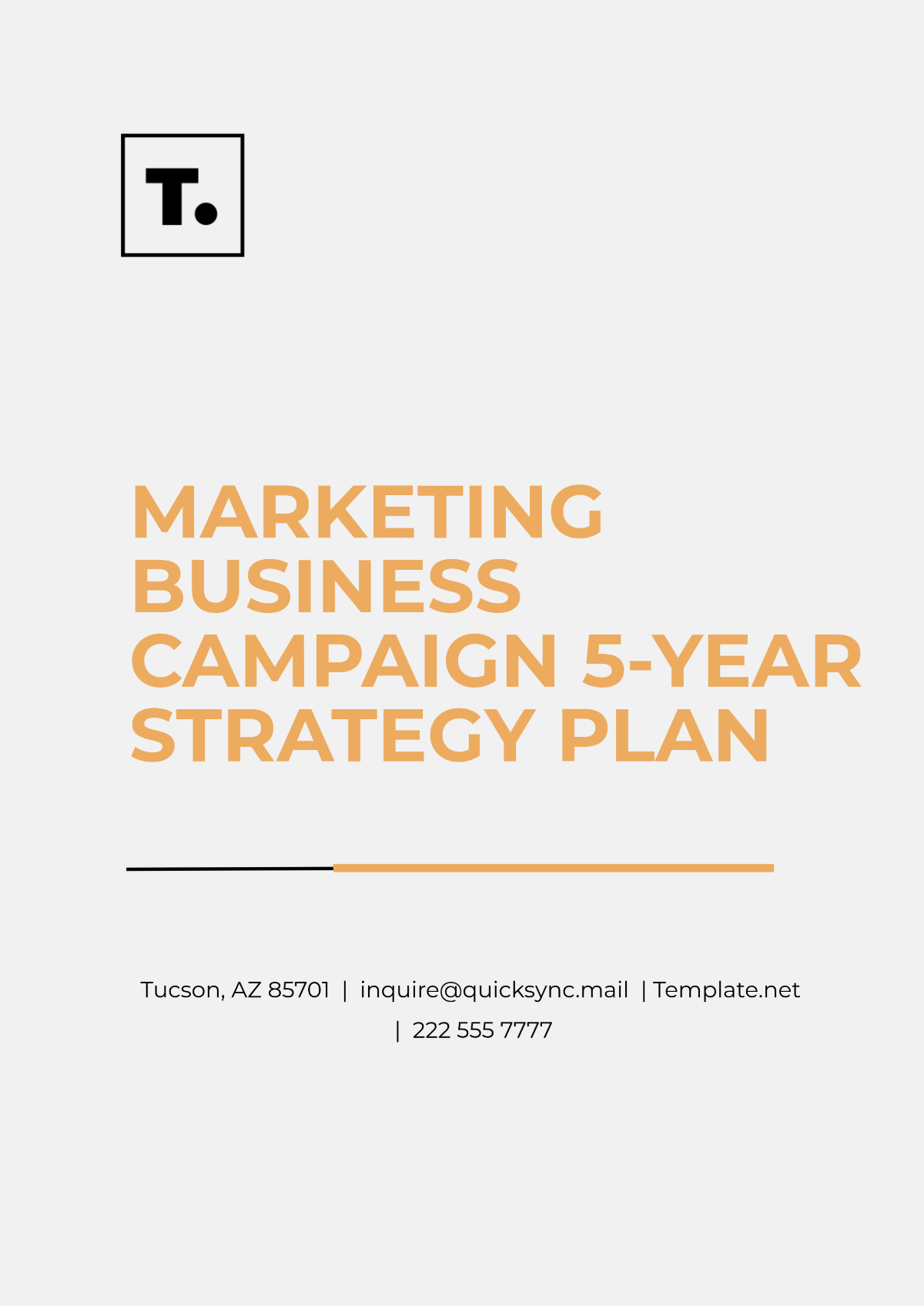Free Marketing Business Campaign 5-Year Strategy Plan

1. Executive Summary
This Marketing Campaign Strategy Plan aims to establish [Your Company Name] as a global leader in eco-friendly consumer electronics by expanding our presence in North America, Europe, and Asia-Pacific from 2060 to 2065. Our strategies focus on innovative marketing techniques, data-driven customer engagement, and promoting sustainable practices, all designed to build a loyal customer base and boost revenue by 40% over the next five years.
2. Mission and Vision Statements
Mission: To deliver cutting-edge, environmentally sustainable consumer electronics that enrich lives and foster environmental stewardship.
Vision: To be the most trusted global brand in eco-friendly electronics by 2065, known for innovation, quality, and a deep commitment to the planet.
3. SWOT Analysis
Strengths:
Strong brand reputation for sustainable products in North America and Europe
Advanced in-house R&D capabilities that drive innovation
Weaknesses:
Limited distribution network in Asia-Pacific
High production costs due to environmentally friendly materials
Opportunities:
Growing demand for sustainable electronics in emerging markets, particularly Asia-Pacific
Advancements in AI and machine learning for enhanced customer personalization
Threats:
Intense competition from well-established global tech brands
Stringent environmental regulations that may increase production costs
4. Goals and Objectives (2060–2065)
Goal 1: Increase global brand awareness by 50% by 2065.
Objective: Conduct a multi-channel brand awareness campaign targeting Asia-Pacific by Q2 2061.
Goal 2: Achieve a 40% growth in new customer acquisition across target regions.
Objective: Launch digital advertising campaigns that leverage AI-driven customer insights in North America and Europe by Q3 2062.
Goal 3: Reduce production costs by 15% while maintaining sustainability standards.
Objective: Invest in new production technology and optimize supplier partnerships by Q4 2064.
5. Key Strategies and Initiatives
Digital Marketing Transformation: Invest in AI-based marketing automation to improve targeting, reach, and engagement across digital platforms.
Customer Personalization Initiatives: Use machine learning to provide personalized experiences based on customer behavior, enhancing loyalty and engagement.
Sustainable Product Campaigns: Launch campaigns highlighting eco-friendly materials and the recyclability of products to appeal to environmentally conscious customers.
Expansion into Asia-Pacific: Build a robust distribution network in Asia-Pacific, focusing on local partnerships to enhance reach and reduce logistics costs.
6. Resource Allocation and Budget
Digital Marketing and Advertising: Allocate 45% of the budget to digital marketing, covering SEO, content marketing, social media, and influencer partnerships.
AI and Data Analytics Tools: Dedicate 20% of the budget to acquiring advanced data analytics tools to better understand and engage customers.
Sustainability Initiatives: Reserve 15% of the budget for eco-friendly packaging and sustainable marketing.
Talent Development: Allocate 5% of the budget for staff training on new digital tools and data privacy regulations.
7. Timeline and Milestones (2060–2065)
2060 Q1: Finalize marketing strategies, secure partnerships for Asia-Pacific expansion, and assign budgets.
2061 Q2: Launch the "Eco Smart Living" brand awareness campaign in Asia-Pacific, targeting environmentally conscious customers.
2062 Q3: Roll out AI-powered digital advertising campaigns in North America and Europe, focusing on product personalization.
2063 Q2: Expand sustainable product lines, including the release of a new eco-friendly product series.
2064 Q4: Implement new cost-saving production technologies to achieve the 15% cost reduction target.
2065 Q4: Complete campaign evaluation and establish next-phase strategic goals.
8. Risk Assessment and Contingency Plans
Risk 1: Regulatory changes impacting the use of data for targeted advertising.
Contingency Plan: Maintain compliance with global data protection laws through regular legal reviews and adapt marketing practices accordingly.
Risk 2: Supply chain disruptions affecting eco-friendly materials.
Contingency Plan: Establish a secondary supplier network and stock critical materials to ensure production continuity.
Risk 3: Increased competition from tech giants in emerging markets.
Contingency Plan: Emphasize XYZ’s unique eco-friendly positioning and reinforce brand identity in key markets.
9. Evaluation and Key Performance Indicators (KPIs)
Brand Awareness Growth: Track brand recall and market reach metrics in Asia-Pacific, aiming for a 10% increase per year.
Customer Acquisition Metrics: Measure growth in new customers acquired from digital campaigns in North America and Europe.
Customer Retention and Engagement Rates: Analyze repeat purchase rates, social media engagement, and email open rates.
Campaign ROI: Assess ROI on each campaign quarterly, adjusting strategy based on performance metrics.
10. Review and Adaptation Process
Annual Review: Conduct yearly reviews to analyze performance relative to set goals and KPIs. Reallocate resources if necessary and adjust strategies.
Quarterly Adjustments: Implement quarterly check-ins for ongoing campaigns to evaluate effectiveness and make necessary optimizations.
End-of-Campaign Evaluation (2065): Analyze overall campaign performance in 2065, documenting learnings and strategic insights for future planning.
- 100% Customizable, free editor
- Access 1 Million+ Templates, photo’s & graphics
- Download or share as a template
- Click and replace photos, graphics, text, backgrounds
- Resize, crop, AI write & more
- Access advanced editor
Achieve consistent brand growth with this Marketing Business Campaign 5-Year Strategy Template. Editable and customizable on Template.net’s Ai Editor Tool, it’s designed to help you create strategic campaigns, set marketing goals, and track progress over five years.
You may also like
- One Page Business Plan
- Coffee Shop Business Plan
- Restaurant Business Plan
- Food Business Plan
- Real Estate Business Plan
- Executive Summary Business Plan
- Cover Page Business Plan
- Nonprofit Business Plan
- Daycare Business Plan
- Construction Business Plan
- Startup Business Plan
- Medical Business Plan
- Bakery Business Plan
- Service Plan
- Hotel Business Plan
- Catering Business Plan
- School Business Plan
- Healthcare Business Plan
- Transportation Plan
- Sports Plan
- Car Wash Business Plan
- Salon Business Plan
- Clothing Business Plan
- Farming Business Plan
- Boutique Plan





























